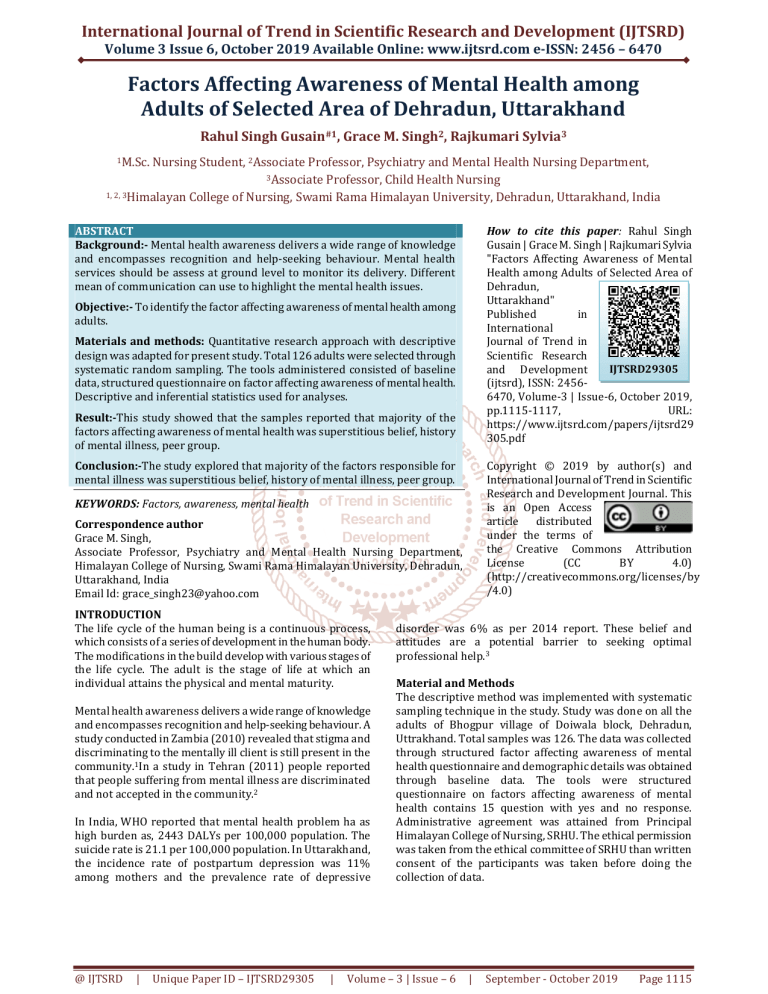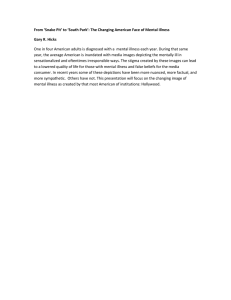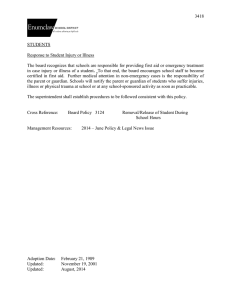
International Journal of Trend in Scientific Research and Development (IJTSRD)
Volume 3 Issue 6, October 2019 Available Online: www.ijtsrd.com e-ISSN: 2456 – 6470
Factors Affecting Awareness of Mental Health among
Adults of Selected Area of Dehradun, Uttarakhand
Rahul Singh Gusain#1, Grace M. Singh2, Rajkumari Sylvia3
1M.Sc.
Nursing Student, 2Associate Professor, Psychiatry and Mental Health Nursing Department,
3Associate Professor, Child Health Nursing
1, 2, 3Himalayan College of Nursing, Swami Rama Himalayan University, Dehradun, Uttarakhand, India
ABSTRACT
Background:- Mental health awareness delivers a wide range of knowledge
and encompasses recognition and help-seeking behaviour. Mental health
services should be assess at ground level to monitor its delivery. Different
mean of communication can use to highlight the mental health issues.
How to cite this paper: Rahul Singh
Gusain | Grace M. Singh | Rajkumari Sylvia
"Factors Affecting Awareness of Mental
Health among Adults of Selected Area of
Dehradun,
Uttarakhand"
Published
in
International
Journal of Trend in
Scientific Research
IJTSRD29305
and Development
(ijtsrd), ISSN: 24566470, Volume-3 | Issue-6, October 2019,
pp.1115-1117,
URL:
https://www.ijtsrd.com/papers/ijtsrd29
305.pdf
Objective:- To identify the factor affecting awareness of mental health among
adults.
Materials and methods: Quantitative research approach with descriptive
design was adapted for present study. Total 126 adults were selected through
systematic random sampling. The tools administered consisted of baseline
data, structured questionnaire on factor affecting awareness of mental health.
Descriptive and inferential statistics used for analyses.
Result:-This study showed that the samples reported that majority of the
factors affecting awareness of mental health was superstitious belief, history
of mental illness, peer group.
Conclusion:-The study explored that majority of the factors responsible for
mental illness was superstitious belief, history of mental illness, peer group.
Copyright © 2019 by author(s) and
International Journal of Trend in Scientific
Research and Development Journal. This
is an Open Access
article distributed
under the terms of
the Creative Commons Attribution
License
(CC
BY
4.0)
(http://creativecommons.org/licenses/by
/4.0)
KEYWORDS: Factors, awareness, mental health
Correspondence author
Grace M. Singh,
Associate Professor, Psychiatry and Mental Health Nursing Department,
Himalayan College of Nursing, Swami Rama Himalayan University, Dehradun,
Uttarakhand, India
Email Id: grace_singh23@yahoo.com
INTRODUCTION
The life cycle of the human being is a continuous process,
which consists of a series of development in the human body.
The modifications in the build develop with various stages of
the life cycle. The adult is the stage of life at which an
individual attains the physical and mental maturity.
Mental health awareness delivers a wide range of knowledge
and encompasses recognition and help-seeking behaviour. A
study conducted in Zambia (2010) revealed that stigma and
discriminating to the mentally ill client is still present in the
community.1In a study in Tehran (2011) people reported
that people suffering from mental illness are discriminated
and not accepted in the community.2
In India, WHO reported that mental health problem ha as
high burden as, 2443 DALYs per 100,000 population. The
suicide rate is 21.1 per 100,000 population. In Uttarakhand,
the incidence rate of postpartum depression was 11%
among mothers and the prevalence rate of depressive
@ IJTSRD
|
Unique Paper ID – IJTSRD29305
|
disorder was 6% as per 2014 report. These belief and
attitudes are a potential barrier to seeking optimal
professional help.3
Material and Methods
The descriptive method was implemented with systematic
sampling technique in the study. Study was done on all the
adults of Bhogpur village of Doiwala block, Dehradun,
Uttrakhand. Total samples was 126. The data was collected
through structured factor affecting awareness of mental
health questionnaire and demographic details was obtained
through baseline data. The tools were structured
questionnaire on factors affecting awareness of mental
health contains 15 question with yes and no response.
Administrative agreement was attained from Principal
Himalayan College of Nursing, SRHU. The ethical permission
was taken from the ethical committee of SRHU than written
consent of the participants was taken before doing the
collection of data.
Volume – 3 | Issue – 6
|
September - October 2019
Page 1115
International Journal of Trend in Scientific Research and Development (IJTSRD) @ www.ijtsrd.com eISSN: 2456-6470
Table no.1 the table of percentage and frequency classification of factor affecting awareness of mental health in
adults
S. No
Factor
Response
Frequency (F)
Percentage (%)
1.
Superstitious belief
Yes
110
87.3
2.
History of mental illness
Yes
105
83.3
3.
Peer group
Yes
104
82.5
4.
Family environment
Yes
103
81.7
5.
Long term physical illness
Yes
111
81.1
6.
Media and technology
Yes
102
81
7.
Financial status
Yes
100
79.4
8.
Low self-esteem and low – confidence
Yes
95
76.4
9.
Social issues and social instability
Yes
96
76.2
10.
Inaccessibility of mental health services
Yes
93
73.8
11.
Occupation and profession
Yes
86
68.3
12.
Physical disability
Yes
85
67.5
13.
Lower literacy rate
Yes
84
66.73
14.
Marriage
Yes
81
64.3
15.
Culture and religion
Yes
74
58.7
Table no.1 Showed that majority 87.3% samples reported
that superstitious belief had effect on mental health, 83.3%
of the samples were aware that history of mental illness was
one of the factor that influence mental health, samples’
responded related to peer group could affect the mental
health i.e 82.5% and mental health in the community was
influenced by family environment i.e 81.7%, long term
physical illness was 81.1 % and 81% were media and
technology. Some other factors like financial status 79.4%,
low esteem and low self-confidence 76.4% and social issues
and social instability 76.2% had effect on mental health.
DISCUSSION
The study aims to recognize the various factors affecting
awareness of mental health A total of 126 samples were
selected in the study, through the systematic random
sampling techniques. The discussion was done according to
objectives and with supportive study
Summary of findings
In the study samples the majority 30.15% of the adults
stayed in the age set of 31- 40 years. 58.7% were females,
57.1 % were residing in the joint family. Maximum of the
sample 33.3 % had secondary education. Family income of
majority 69.84 % of the sample was between Rs 500010000. 65.07% were married, 95.2% followed the Hindu
religion. Whole sample 100% had reported that they don’t
have any source of information regarding mental health and
also don’t have any past history of mental illness.
In the study it showed that various factors like superstitious
belief, peer pressure, history of mental illness have
influencing factor on awareness of mental health.
Factors affecting awareness of mental health among
adults
The present study had acknowledged various factor affecting
awareness of mental health in the community as
@ IJTSRD
|
Unique Paper ID – IJTSRD29305
|
superstition, history of mental illness, peer group and family
environment. Similar studies were also done on factors.
Chadda RK, Patra BN, Gupta N. (2013) reported that
community mental health refers to the treatment of mental
health disorders. According to many epidemiological studies
of psychiatric disorder have been conducted in India on
general population in the community. The prevalence rate
varies from 9.5 to 370/1000 population. India is a culturally
diverse country, explanations for mental disorders have
been influenced by system of traditional medicine,
supernatural beliefs, poor socioeconomic status of the
people and limited awareness regarding mental illness in the
community4
Gureje O, Lasebikan VO, Ephraim-Oluwanuga O, Olley
BO, Kola L. (2005) conducted the study on knowledge and
altered to mental illness. The purpose was to determine the
community attitude and awareness. A multistage, clustered
sample of household respondents was studied in three states
in the Yoruba-speaking parts of Nigeria (representing 22%
of the national population). Total 2040 individual included in
the study. The study concluded that low knowledge is a
concern in the community which leads to a negative view of
mental illness. Stigmatization of mental illness was more
prevalent in the Nigerian community.5
Strengths
The current study had the following strengths:
1.
Sample size was calculated to determine the appropriate
sampling technique.
Limitations
1. The opinion was on the basis of Yes and No which was
limited to the area of response.
2.
Small sample size limits the generalization of the result.
Volume – 3 | Issue – 6
|
September - October 2019
Page 1116
International Journal of Trend in Scientific Research and Development (IJTSRD) @ www.ijtsrd.com eISSN: 2456-6470
Conclusion
The study established that some factors like superstitious,
history of mental illness, family environment, financial
status, and peer group affect to mental health.
REFERENCES
[1] Kapungwe A, Cooper S, Mwanza J, Mwape L, Sikwese A,
Kakuma R, Lund C, Flisher AJ. Mental illness-stigma and
discrimination in Zambia. African Journal of Psychiatry.
2010;13(3).
[2] Ghanean H, Nojomi M, Jacobsson L (2011) Internalized
Stigma of Mental Illness in Tehran, Iran. Stigma
Research and Action 1: 11–17.
@ IJTSRD
|
Unique Paper ID – IJTSRD29305
|
[3] World health organization, Mental health in India 2019
[internet],
2019,
Available
from:
http://www.searo.who.int/india/topics/mental_health
/about_mentalhealth/en/
[4] Chadda RK, Patra BN, Gupta N. Recent developments in
community mental health: Relevance and relationship
with the mental health care bill. Indian Journal of Social
Psychiatry. 2015 Apr 1;31(2):153.
[5] Gureje O, Lasebikan VO, Ephraim-Oluwanuga O, Olley
BO, Kola L. Community study of knowledge of and
attitude to mental illness in Nigeria. The British Journal
of Psychiatry. 2005 May; 186(5):436-41.
Volume – 3 | Issue – 6
|
September - October 2019
Page 1117




